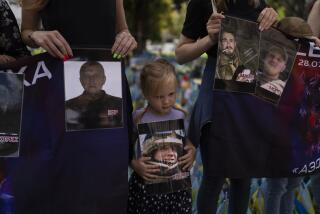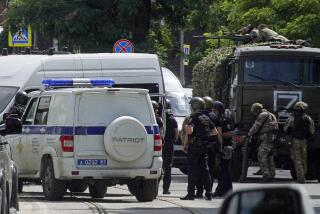Rescue Team Safely Frees Prison Hostages in 3-Minute Raid That Lights Up the Sky : Immigration: Some Cubans face immediate deportation. Explosives blow up part of the unit, apparently catching inmates by surprise.
- Share via
TALLADEGA, Ala. — On a day mixed with explosive force, joyful reunions and shattered dreams, a swift pre-dawn assault by a special rescue team Friday freed nine hostages, ending a 10-day takeover of an Alabama prison unit and dooming dozens of Cuban inmates to immediate deportation.
At 3:43 a.m., a series of explosions rocked the ground and lit up the sky around the Federal Correctional Institution here as scores of rescue team members swarmed over Alpha unit, the housing area that had been seized on Aug. 21 by Cuban inmates fighting deportation to their homeland.
The assault, in which explosives blew up part of the housing unit, apparently caught the inmates by surprise. It lasted only three minutes.
Thirty-two inmates who had been scheduled to be deported the day before the takeover will be flown back to Cuba today, said an immigration official, ending their longtime hope of remaining in the United States.
Minutes after about 200 members of the FBI Hostage Rescue Team and other FBI and Bureau of Prisons tactical staff stormed the prison--some entering through the roof, where the explosions were visible from a road that runs in front of the sprawling prison complex--team members were seen leaving the prison in car after car, giving the thumbs-up sign and shouting, “It’s over!” Others slapped hands in elation.
Family members of the former hostages were overjoyed at having their loved ones back. A close relative of hostage Mark Tinsley said she had seen all nine. “They’re all in good condition,” she said. A 10th hostage, Kitty Suddeth, was released Wednesday.
One Cuban was injured slightly, federal officials said.
The officials said they decided to make their move, rather than continuing to negotiate, because the Cubans, whom they called “terrorists,” had begun fighting among themselves, signaling dangerous instability. They had attacked prison staff members and had threatened to throw one hostage from the roof and stab at least one more.
Roger Scott, the prison warden, said hostages, when receiving medical treatment Thursday, had sent out messages “indicating they believed this might be their final opportunity to communicate with their loved ones.”
Scott did not explain how the messages were communicated, but one official speculated that sign language was used.
The warden said that the hostages--three Immigration and Naturalization Service employees and six Bureau of Prisons employees--were ordered to place their identification cards in a pillowcase. One card was drawn, he said, adding, “That person was informed that he would be killed.”
“The Cubans did not negotiate in good faith,” Scott said.
He added that the inmates had fashioned an “extensive armory” of weapons, including knives, spears, swords, even bows and arrows.
Other federal officials also went to great lengths to portray the Cubans as deadly.
“Terrorists” is what Acting Atty. Gen. William Barr called them, abandoning the government’s usual, more neutral word, detainees.
Barr, along with Michael Quinlan, director of the Bureau of Prisons, and FBI Director William S. Sessions, flew here from Washington hours after the assault to praise the rescue teams.
Although they were portrayed as very dangerous, the Cubans seemed to put up no fight. Officials said they suspected that the inmates, perhaps sleepy, were stunned into submission by explosives.
Barr, who said President Bush had telephoned him to express appreciation for “a job well done,” told reporters that he and other officials had met Thursday night to decide whether to attack.
Once the decision was made, the rescue team, made up of people from Atlanta, Birmingham, Ala., and Knoxville, Tenn., swung into action.
Before the attack began, reporters and television technicians keeping vigil outside the prison noticed a flurry of activity: Ambulances rushed toward the building, and reinforcements were brought in. A guard at the road stood on his automobile and peered intently toward the besieged building.
Just before the attack, guarded communications were heard on a radio frequency used by the rescue team:
“Go on three,” said a muffled voice.
“We’re ready to go,” came the reply.
Shortly after that, there were three loud pops, the go signal, soon followed by a huge, Earth-rattling sound, the main charge that flashed on the roof’s left side.
Team members, dressed in dark, close-fitting uniforms and silhouetted in light from pole lamps, scurried across the prison roof, where only a day earlier inmates had hung bedsheet banners seeking media attention.
One team member ripped down a banner. Another hauled down what appeared to be a Cuban flag.
In a matter of minutes, it was over.
“Yahoo! We did it!” one man shouted.
“No injuries!” yelled another.
“Did we do it?”
“Awriiiiight!”
Federal officials said that the hostages had barricaded themselves in one room inside the maximum-security cellblock, using mattresses to prevent Cubans from getting in.
“When the operation went down, they did try to rush the hostage area,” said Tom Fischer, INS Atlanta district director.
Fischer, talking with reporters as he toured the heavily damaged facility, vowed to “follow up with our plans to repatriate” the 32 inmates today.
While 121 Cubans were detained here, it is unclear how many participated in the uprising, which followed anti-deportation riots in Atlanta and Oakdale, La., in 1987. Some inmates reportedly protected hostages throughout the uprising here. There were also 18 American inmates housed in the cellblock.
Nationwide, about 2,500 Cubans are held in more than 60 federal facilities, awaiting deportation or deportation hearings because of criminal records. They are among the 125,000 who poured onto U.S. shores during the 1980 Mariel boatlift.
The aftermath of the takeover and rescue included twisted doors, broken windows and a surreal courtyard scene near Alpha unit, where hundreds of blue canvas shoes and socks lay in the grass--part of the clothing inmates shucked off during searches for weapons.
Staff researcher Edith Stanley in Atlanta contributed to this story.
More to Read
Sign up for Essential California
The most important California stories and recommendations in your inbox every morning.
You may occasionally receive promotional content from the Los Angeles Times.










